The extent of intrauterine growth restriction determines the severity of cerebral injury and neurobehavioural deficits in rodents
- PMID: 28934247
- PMCID: PMC5608203
- DOI: 10.1371/journal.pone.0184653
The extent of intrauterine growth restriction determines the severity of cerebral injury and neurobehavioural deficits in rodents
Abstract
Background: Cerebral Palsy (CP) is the most common physical pediatric neurodevelopmental disorder and spastic diplegic injury is its most frequent subtype. CP results in substantial neuromotor and cognitive impairments that have significant socioeconomic impact. Despite this, its underlying pathophysiological mechanisms and etiology remain incompletely understood. Furthermore, there is a need for clinically relevant injury models, which a) reflect the heterogeneity of the condition and b) can be used to evaluate new translational therapies. To address these key knowledge gaps, we characterized a chronic placental insufficiency (PI) model, using bilateral uterine artery ligation (BUAL) of dams. This injury model results in intrauterine growth restriction (IUGR) in pups, and animals recapitulate the human phenotype both in terms of neurobehavioural and anatomical deficits.
Methods: Effects of BUAL were studied using luxol fast blue (LFB)/hematoxylin & eosin (H&E) staining, immunohistochemistry, quantitative Magnetic Resonance Imaging (MRI), and Catwalk neurobehavioural tests.
Results: Neuroanatomical analysis revealed regional ventricular enlargement and corpus callosum thinning in IUGR animals, which was correlated with the extent of growth restriction. Olig2 staining revealed reductions in oligodendrocyte density in white and grey matter structures, including the corpus callosum, optic chiasm, and nucleus accumbens. The caudate nucleus, along with other brain structures such as the optic chiasm, internal capsule, septofimbrial and lateral septal nuclei, exhibited reduced size in animals with IUGR. The size of the pretectal nucleus was reduced only in moderately injured animals. MAG/NF200 staining demonstrated reduced myelination and axonal counts in the corpus callosum of IUGR animals. NeuN staining revealed changes in neuronal density in the hippocampus and in the thickness of hippocampal CA2 and CA3 regions. Diffusion weighted imaging (DWI) revealed regional white and grey matter changes at 3 weeks of age. Furthermore, neurobehavioural testing demonstrated neuromotor impairments in animals with IUGR in paw intensities, swing speed, relative print positions, and phase dispersions.
Conclusions: We have characterized a rodent model of IUGR and have demonstrated that the neuroanatomical and neurobehavioural deficits mirror the severity of the IUGR injury. This model has the potential to be applied to examine the pathobiology of and potential therapeutic strategies for IUGR-related brain injury. Thus, this work has potential translational relevance for the study of CP.
Conflict of interest statement
Figures

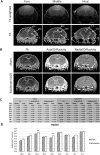
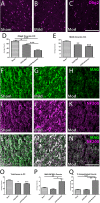
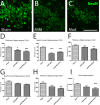

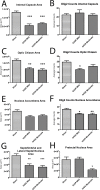
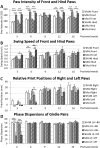
Similar articles
-
Broccoli sprout supplementation during pregnancy prevents brain injury in the newborn rat following placental insufficiency.Behav Brain Res. 2015 Sep 15;291:289-298. doi: 10.1016/j.bbr.2015.05.033. Epub 2015 May 23. Behav Brain Res. 2015. PMID: 26014855
-
Neuropathology in intrauterine growth restricted newborn piglets is associated with glial activation and proinflammatory status in the brain.J Neuroinflammation. 2019 Jan 8;16(1):5. doi: 10.1186/s12974-018-1392-1. J Neuroinflammation. 2019. PMID: 30621715 Free PMC article.
-
GABAA receptor expression and white matter disruption in intrauterine growth restricted piglets.Int J Dev Neurosci. 2017 Jun;59:1-9. doi: 10.1016/j.ijdevneu.2017.02.004. Epub 2017 Feb 20. Int J Dev Neurosci. 2017. PMID: 28219764
-
Blocked, delayed, or obstructed: What causes poor white matter development in intrauterine growth restricted infants?Prog Neurobiol. 2017 Jul;154:62-77. doi: 10.1016/j.pneurobio.2017.03.009. Epub 2017 Apr 6. Prog Neurobiol. 2017. PMID: 28392287 Review.
-
Thyroid hormone analogues: Promising therapeutic avenues to improve the neurodevelopmental outcomes of intrauterine growth restriction.J Neurochem. 2024 Sep;168(9):2335-2350. doi: 10.1111/jnc.16124. Epub 2024 May 14. J Neurochem. 2024. PMID: 38742992 Review.
Cited by
-
Combination of human endothelial colony-forming cells and mesenchymal stromal cells exert neuroprotective effects in the growth-restricted newborn.NPJ Regen Med. 2021 Nov 18;6(1):75. doi: 10.1038/s41536-021-00185-5. NPJ Regen Med. 2021. PMID: 34795316 Free PMC article.
-
Neonatal Morbidities of Fetal Growth Restriction: Pathophysiology and Impact.Front Endocrinol (Lausanne). 2019 Feb 7;10:55. doi: 10.3389/fendo.2019.00055. eCollection 2019. Front Endocrinol (Lausanne). 2019. PMID: 30792696 Free PMC article. Review.
-
Enduring effects of acute prenatal ischemia in rat soleus muscle, and protective role of erythropoietin.J Muscle Res Cell Motil. 2025 Mar;46(1):23-34. doi: 10.1007/s10974-024-09684-6. Epub 2024 Nov 16. J Muscle Res Cell Motil. 2025. PMID: 39549147
-
Antenatal low-intensity pulsed ultrasound reduces neurobehavioral deficits and brain injury following dexamethasone-induced intrauterine growth restriction.Brain Pathol. 2021 Nov;31(6):e12968. doi: 10.1111/bpa.12968. Epub 2021 May 7. Brain Pathol. 2021. PMID: 33960564 Free PMC article.
-
Establishment of a Novel Fetal Growth Restriction Model and Development of a Stem-Cell Therapy Using Umbilical Cord-Derived Mesenchymal Stromal Cells.Front Cell Neurosci. 2020 Jul 28;14:212. doi: 10.3389/fncel.2020.00212. eCollection 2020. Front Cell Neurosci. 2020. PMID: 32848614 Free PMC article.
References
-
- Jantzie LL, Robinson S (2015) Preclinical Models of Encephalopathy of Prematurity. Dev Neurosci 37: 277–288. doi: 10.1159/000371721 - DOI - PMC - PubMed
-
- Colver A, Fairhurst C, Pharoah PO (2014) Cerebral palsy. Lancet 383: 1240–1249. doi: 10.1016/S0140-6736(13)61835-8 - DOI - PubMed
-
- Surveillance of Cerebral Palsy in Europe S (2002) Prevalence and characteristics of children with cerebral palsy in Europe. 44: 633–640. - PubMed
-
- Himmelmann K, Hagberg G, Beckung E, Hagberg B, Uvebrant P (2005) The changing panorama of cerebral palsy in Sweden. IX. Prevalence and origin in the birth-year period 1995–1998. Acta Paediatr 94: 287–294. - PubMed
-
- Jacobsson B, Ahlin K, Francis A, Hagberg G, Hagberg H, Gardosi J (2008) Cerebral palsy and restricted growth status at birth: population-based case-control study. BJOG 115: 1250–1255. doi: 10.1111/j.1471-0528.2008.01827.x - DOI - PubMed
MeSH terms
LinkOut - more resources
Full Text Sources
Other Literature Sources
Research Materials
Miscellaneous

